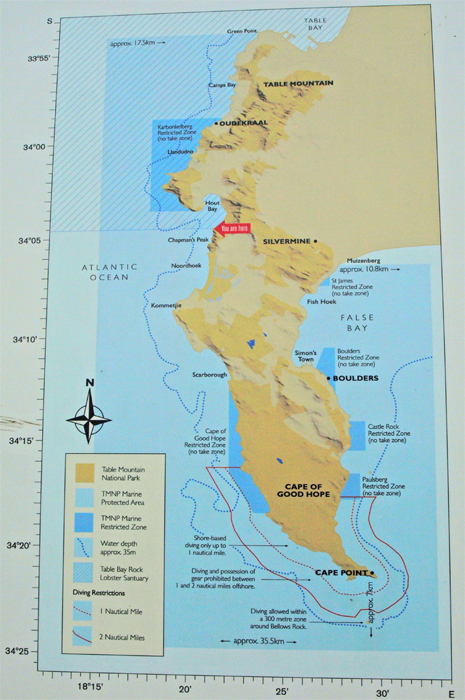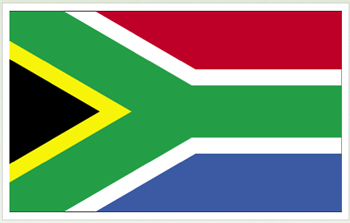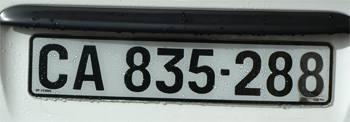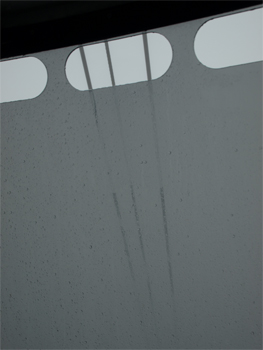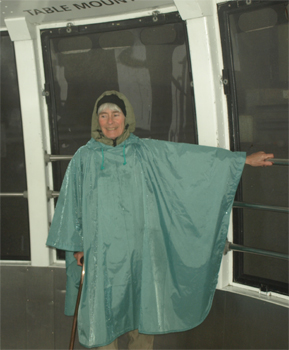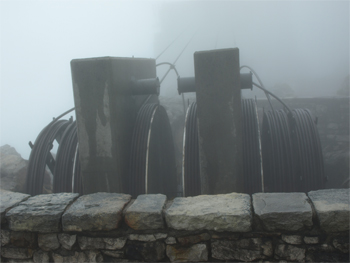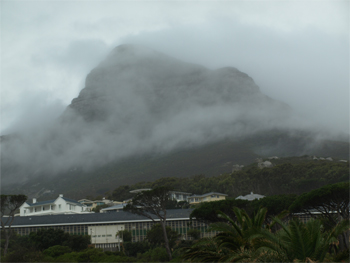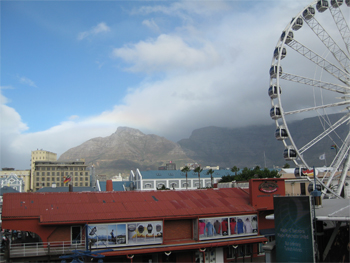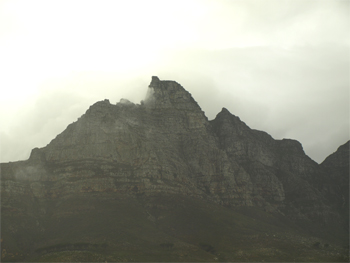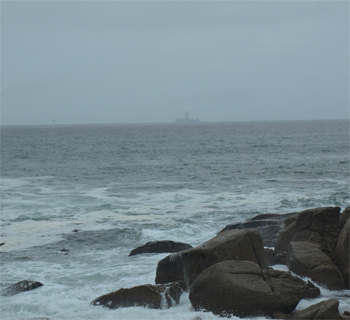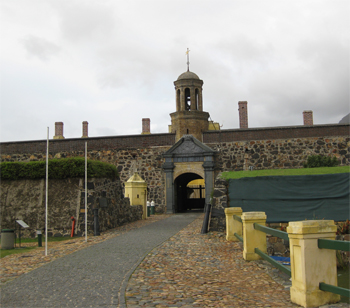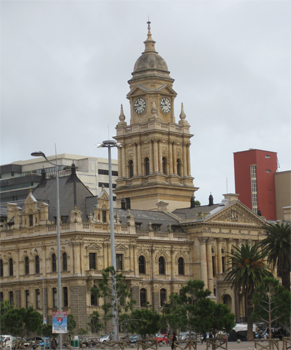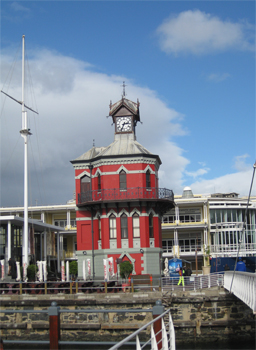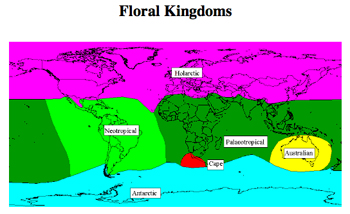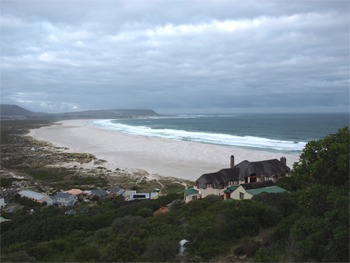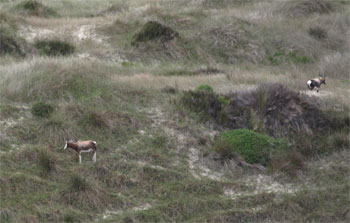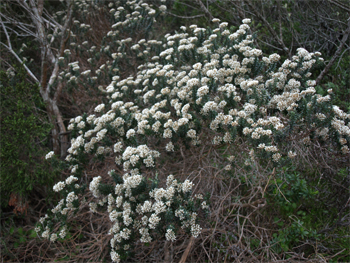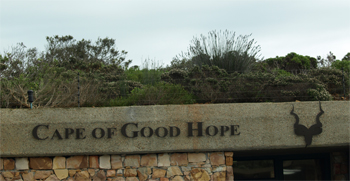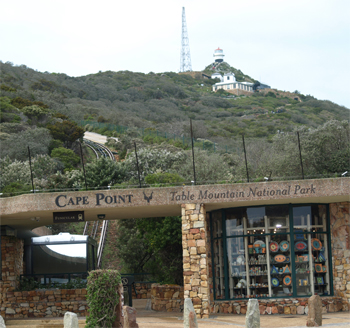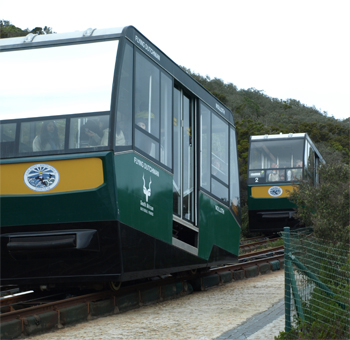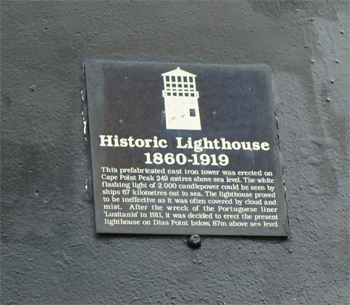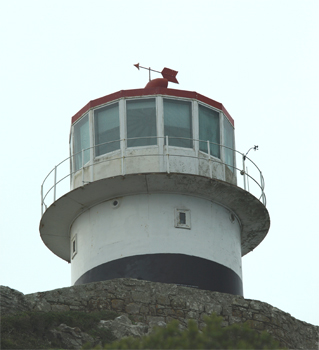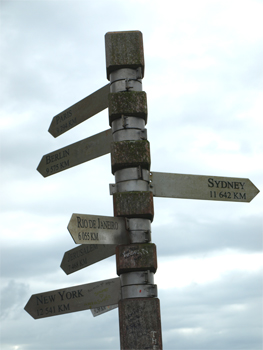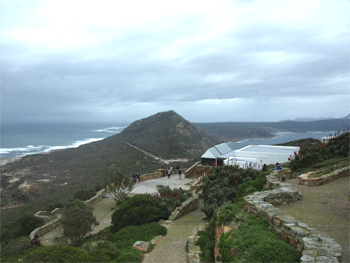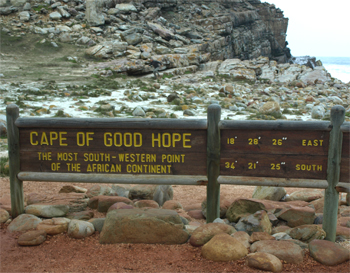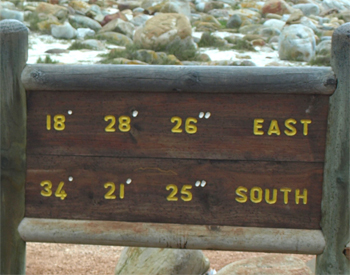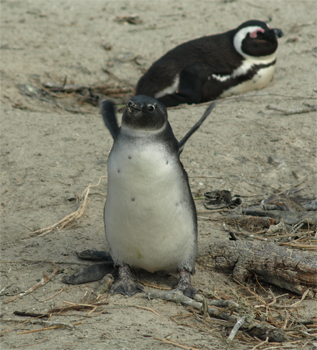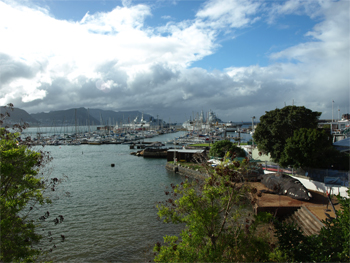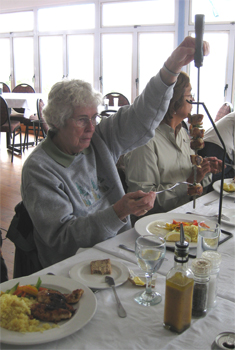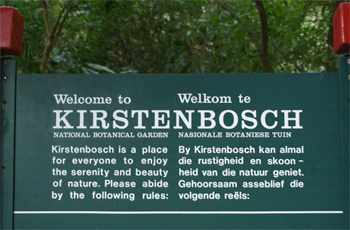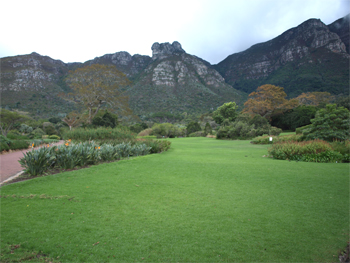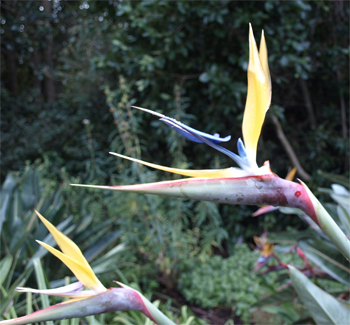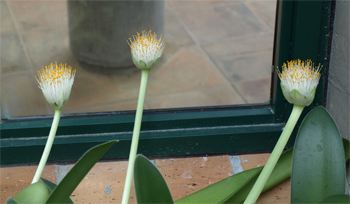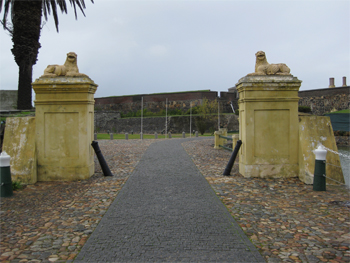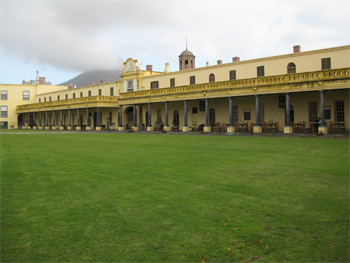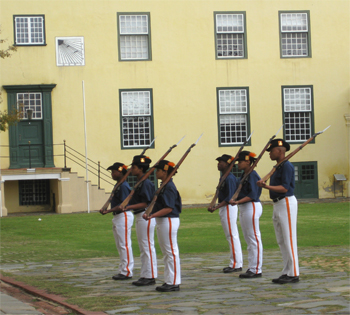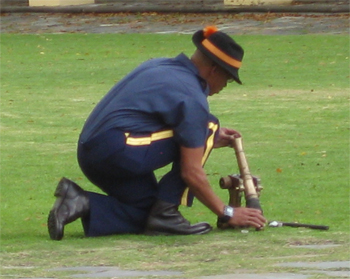May 27 - June 1 - Cape Town, South Africa
This morning, while waiting for our 11 AM departure from Victoria Falls, we were entertained by watching the monkeys invade the restaurant and our balcony.
Boring
|
But comfortable - this is why we couldn't open the doors to our verandah! The little beggars will come in a steal everything moveable.
|
We flew British Airways from Vic Falls, Zimbabwe (what a crammed jam that little airport was!) to Johannesburg, South Africa, where we had to go through customs again and then wait for our next BA flight to Cape Town, SA.
Map of the Cape of Good Hope region - Cape Town is just north of the peninsula and is on the Atlantic Ocean. The Cape itself is bounded on the west by the Atlantic and on the East by the Indian Ocean.
|
|
Flag of South Africa |
South African License Plates
|
We were met at the airport by our new OAT trip leader, Kim, at 9 PM. She drove us to the hotel, St. George's, on the mall in center city. She tried to point out some landmarks on the way into Cape Town but it was too dark and the windows on this minibus/van were too low to see anything but the curb. Also, it was raining.
Our hotel room is very nice. It is almost like a suite with plenty of room, a couch, a desk and chair, and an eating table with two more chairs.
Cape Town touts that it has the third best drinking water in the world. We can drink tap water for the first time in three weeks.
Since it is practically the middle of winter in southern Africa, and Cape Town is on the Atlantic Ocean, it rains. It rained most of the time we were there. None the less, we were able to do several tours both with Kim and on our own.
The first day's orientation tour included taking the funicular to the top of Table Mountain and driving around to see the various city sites.
|
|
The weather was nasty but we took a chance that it might clear and went off to ride to the top of Table Mountain anyway. Kim had tickets and there was no guarantee any other day would be better. Later in the day it cleared off but they had to close the funicular due to high winds - which often happens.
|
The view out the funicular car window was not too great.
|
Gale inside the funicular car - dressed for the weather
|
Funicular's cables - and the weather |
At least we got to see the Table Mountain model. Table Mountain is a large sort of plateau with several other peaks identified. It is protected as a very large park. The city of Cape Town is built all around the base of the Mountain.
|
A little later you could see a little of Table Mountain
|
More views of Table Mountain on slightly better days
|
Table Mountain - from the waterfront |
Table Mountain - from the waterfront
|
Table Mountain - from the east side |
Camps Bay Beach complete with two surfers on this chilly morning.
|
If you look carefully, you can see a diamond dredger out in the bay. Alluvial diamonds are washed out to sea from rivers such as the Orange River near Namibia. The ship rakes up the sand and separates the diamonds. Obviously this is a controlled activity.
|
We stopped to look at the entrance to the 1666 Castle of Good Hope. We may have time to come back and take a tour of it. Across the street is the City Hall with its clock tower and the balcony from which Nelson Mandela gave his famous "freedom speech" in 1990.
|
The Castle
|
City Hall
|
At 12:00 noon every day a cannon is shot off on Signal Mountain. In the past it indicated that it was time for the farmers to bring their produce into the Green Market to sell or trade. |
We drove through the Bo-Kaap section, an area of brightly colored small houses. When the Colored slaves (Colored people are a mix of white and black blood, not Africans) got their freedom, they settled in this area. Since they could not read or count, they painted their houses different bright colors in order to identify their own. It is now an upscale, fancy neighborhood.
|
Houses in the Bo-Kaap section
|
Kim dropped us at the Victoria and Albert Wharf and gave us a quick orientation. It is very much like the Baltimore Inner Harbor or the San Diego waterfront. It was alive with locals today as it is Saturday.
|
Cape Town waterfront
|
Cape Town waterfront - Victoria and Albert Wharf |
Clock Tower - an icon of the old docks area
|
For dinner we were driven to a northern suburb of Cape Town to the home of a Colored family (Reggie and Hazel). The community was entirely Colored and at first the white OAT groups stopping to enter a house created some gawking by the neighbors. Reggie was the cook and a talented craftsman who has built onto his original two-room house. He and Hazel were very candid about their ideas on the political situation is SA both before and after apartheid. The meal was good and all ten of us sat at the table together with our hosts.
On our second day in Cape Town, we were taken on a tour of the Cape Peninsula. We headed out at 8:30 AM with our ponchos, rain pants, and winter hats, gloves, and scarves, since it was supposed to rain all day and was pretty chilly and damp. We rode down the west coast of the Cape Peninsula which is covered with Fynbos (fine bush)-also called Cape, which is one of the six floral kingdoms that cover our earth. The other floral kingdoms are Boreal (or Holarctic like the US), Sub-tropic (or Palaeotropical) , Tropic (or Neotropical), Australian, and Antarctic. Fynbos is found only on the Cape Peninsula. It includes about 350 species of Protea bushes (the King Protea is the national flower of SA), bulb plants, heather, geraniums (which originated on this cape), and strong fire-resistant reeds (Elegia Nuda), which are used to make the thatched roofs of many SA houses.
Floral kingdoms - the red is the Fynbos of the Cape Peninsula
|
|
Above Noordhoek Beach we looked down at the bay, the wide white sand beach, and horse stud farms. The ocean waves were quite high because of the cold front still moving in.
|
|
Kim pointed out the road warning sign that said "Robot." Traffic lights in SA were introduced as "robotic traffic lights" and the warning has been reduced to just, robot.
We finally saw some animals among the fynbos in the Cape of Good Hope Nature Reserve: Eland, Bontebok (the symbol of the Reserve) and some flowers and trees. Among the latter was the Aloe Ferox and an interesting umbrella tree, the Cape cedar. Metalasia is a white flower bush that is often used in flower arrangements. (These plants are examples of fynbos flora.) The park also has many naughty, aggressive baboons, and ostriches.
Bontebok - they have a hump, and a white face and butt
|
Aloe Ferox |
Cape Cedar |
Metalasia
|
At Cape Point, we rode the Flying Dutchman Funicular up to the old cape lighthouse. From the top we could look out on both the colder Atlantic and the warmer Indian Ocean. The lighthouse was replaced by a lower one, because the fog and mist are often so thick that the original light was obscured. We walked back down and rode to the Cape of Good Hope, the most southwestern point of Africa. We had our picture taken in the rain. On the way out of the park we watched a baboon eat a Protea flower.
|
Visitor Center
|
Flying Dutchman Funicular |
Flying Dutchman Funicular - passing zone
|
|
|
We are a long way from anywhere
|
Atlantic Ocean on the left and the Indian Ocean on the right |
We walked back down and drove to the Cape of Good Hope, the most southwestern point of Africa. We had our picture taken in the rain. |
|
Closer view of the coordinates - this is really not that far south
|
We were there photo! - It was cold, windy, and raining and 300 other people wanted a photo from this location.
|
On the way out of the park we watched a baboon destroy a Protea flower.
|
 |
The next stop was at the Penguin Colony at Boulders Beach near Simon's Town on the eastern side of the peninsula. (Simon Vander Stel was the first governor of the Cape Colony.) These are African Jackass penguins and are currently sitting on their eggs. Penguins usually mate for life, and take turns sitting on the eggs. The other spouse goes to sea to eat fish and then regurgitate it for the chicks that can't swim until their down disappears and they grow waterproof feathers. This takes at least 60 days. Females usually lay two eggs twice each year. I think penguins are cute and fun to watch walk.
We ate a nice lunch at the Black Marlin Restaurant in Simon's Town. The town is an active naval base and we took pictures of a statue of Able Seaman Just Nuisance, a Great Dane adopted by sailors during WWII.
|
Bay and naval yard at Simon's Town
|
Able Seaman Just Nuisance |
Negiotiating the fish off the skewer on the stand
|
It was still raining off and on, but we made our last tour stop at Kirstenbosch National Botanical Garden. The garden is on the east side of Table Mountain in suburban Cape Town and was owned by several British government favorites including Cecil Rhodes. The estate covers 528 hectares with 36 hectares of cultivated fynbos (all indigenous plants) and the rest is Afromontane forest. Of special interest on our rain shortened visit was the unique "Mandela Gold" bird-of-paradise plant. The flower is blue and gold. We walked to a section that contained varieties of cycads, which grow only 3 mm a year and are between 250 and 300 million years old! They are living fossils (raining too hard for photos).
We made a quick trip around the conservatory (in out of the rain) and took pictures of the South African paint brush (Haemanthus Albiflos), which is nothing like our Rocky Mountain paint brush. We would have liked to spend the day in the gardens with sunny weather!
|
|
"Mandela Gold" Bird-of-Paradise plant
|
South African paint brush (Haemanthus Albiflos) |
Another rainy day - last week it was sunny! - but we decided to go out anyway. We walked first to the Castle of Good Hope. It was built between 1666 and 1679 and is the oldest surviving building in SA - not quite as old as the pyramids! We entered the pentagon-shaped structure through the Lion Gate (one male and one female lion made of terra cotta) and then under the bell tower. The bell was used to toll the hours, warn the citizens of danger, and to call people together for important announcements.
The fort was originally built to protect the Dutch East India Company laborers from enemy attacks (especially pirates) and contained a hospital, church, and school. Later it was enlarged by the Brits to garrison more soldiers and sailors.
The Castle - Lions Gate |
The Castle - Bell Tower
|
We joined a tour and learned about the "castle." The governor and "second in command" had houses in the middle block. We later walked through the quarters. Three upstairs bedrooms in the governor's house were converted into a long reception and dining room. The room is set with end-to-end tables that can seat 100 people. It is still used for special events.
|
|
The Castle - Courtyard
|
There was a special exhibit in one of the areas that displayed costumes from the Cape Town Kaapse Klopse which is a minstrel festival held annually on January 2. We think it is much like the Philadelphia Mummers' Parade. Silky outfits and feathers are worn by the participants. There are prizes for costumes, dance struts, and music. They compete in three song types: Klopse, Nagtroepe, and Christmas bands. The young docent had, of course, never heard of the Mummers. (No photos allowed in the exhibit.)
|
At noon we stood in the courtyard and watched the "changing of the keys" ceremony and the shooting of the noon cannon. This looked like a ritual performed by young colored people as a heritage or historical display. The cannon was used to signal outlying farmers that ships were coming into the harbor.
|
Changing of the Keys Ceremony
|
Changing of the Keys Ceremony
|
Changing of the Keys Ceremony |
It started to rain heavily again so we ducked into the military museum of uniforms (many different ones used here over the years), weapons, and medals. There were displays telling some of the history of the Frontier Wars against the native Xhosa people and also the Boer Wars.
It stopped raining for a while so we walked to the Slave Lodge Museum near St. George's Anglican Church and the Company Gardens. The slaves used in southern Africa originally came from Madagascar and Mozambique and later from India and Indochina. The slaves lived here and were taken out to labor on public works and at the Company outposts. Slave rebellions in America helped fuel the abolition movement in Britain but it was a slow process here. The emancipation of slaves (the end of slave trade) in the Cape occurred in 1934, but the slaves were not freed. They were "apprenticed" to their former owners without pay for four years. Slavery continues worldwide in the forms of: debt bondage, serfdom human trafficking, sexual exploitation, and child labor. It is estimated the 300,000 child soldiers are being used worldwide. It was a grim explanation of how man can treat his fellow man. This museum also had a lengthy exhibition detailing Nelson Mandela's life and the people who influenced his ideas and ideals and how his character evolved over his lifetime.
It rained hard on our way back to the hotel where we dried out, ate fruit for a late lunch, and rested.
At 6PM we met Marie and Grace in the lobby to go out for dinner. It was raining so hard that the wind was blowing the revolving door so it was spinning like a pinwheel. We waited until it calmed down and then had the hotel shuttle drive us to the waterfront and the Hildebrand Italian Restaurant. Not many people were out in this storm so we practically had the place to ourselves. The others had lasagna and I ventured the "ostrich and beetroot" ravioli. I wanted to taste ostrich meat to add to my warthog meat African experience. It tasted like dark meat duck and not like chicken. It had an interesting flavor but I won't be ordering it again. It was a nice peaceful dinner. The hostess called for our shuttle to come pick us up. It was nice having door-to-door service without dealing with taxi drivers.
Tues., 5/31/11 - Cape Town to London
The day started out partly sunny but by 10 AM it clouded over and we had intermittent showers. We were able to stay dry. We walked from the hotel to the waterfront and took "Tommy the Tug" ferry across to the upscale mall. The ferry/taxi was being used because the connector swing bridge was under reconstruction.
We wandered through the Red Barn craft mall and then into the Victoria and Albert Mall. We walked and enjoyed the exercise; sat in the Dodge Cafe (retro 50's) and drank a mocha chino; and then took a cab back to the hotel.
We spent the afternoon in our room reorganizing for the long flights home. Kim took us to the airport and we flew to London on British Air. It was an 11 and a half hour flight.
Wed., 6/1/11 - London to Denver
We had lots of time (nine hours!) to kill in Heathrow Airport and spent most of it with Marie and Grace. The 10 1/2 hours in the air to Denver was tough because it was daylight all the way. It was like floating in space while the earth rotated below us.
We arrived back in Estes Park at 10 PM and were, of course, very happy to be home. The trip was quite an experience - seeing all the wonderful animals and birds and learning about a part of the world we had never seen before.
Continue on next page which begins the list and pictures of all of the animals we saw.
| Return to Top | Return to Itinerary | Return to Dreamcatcher Home Page |


